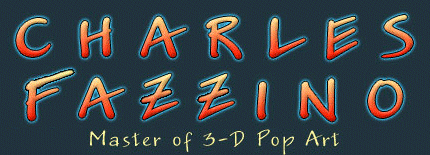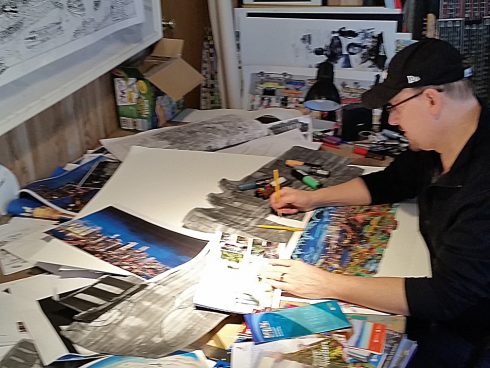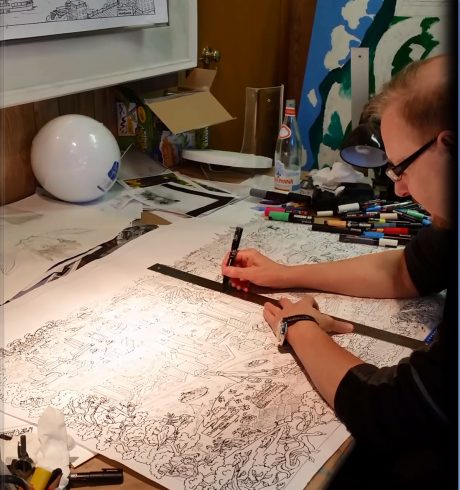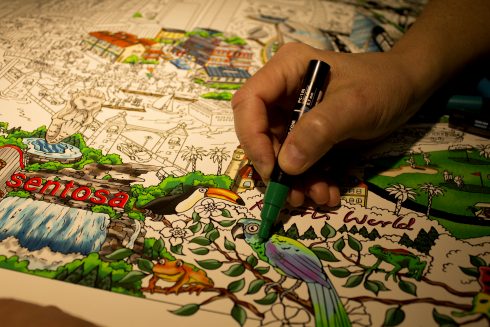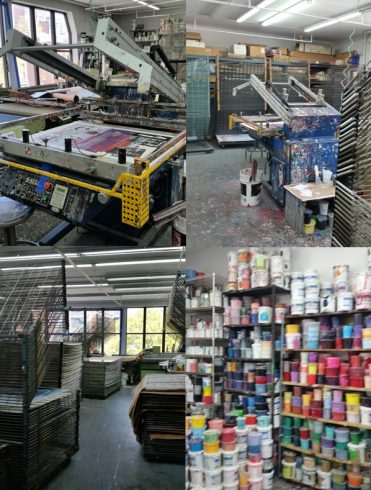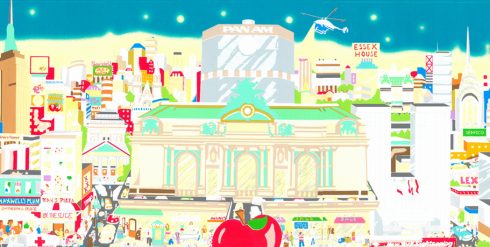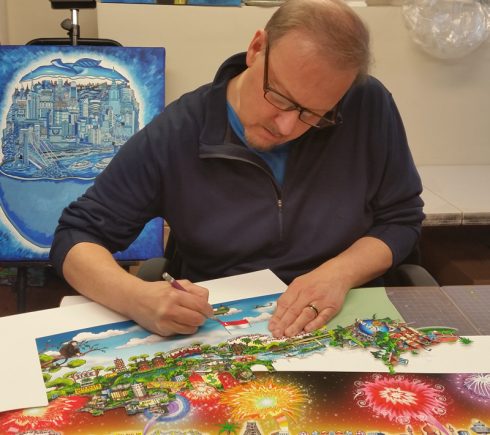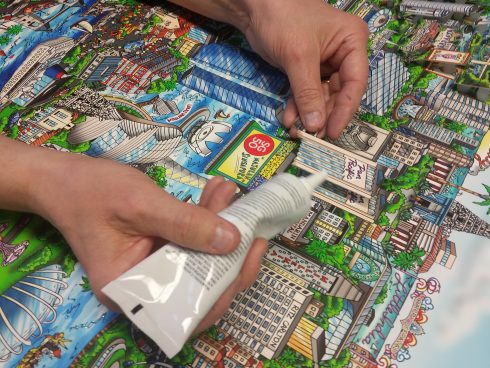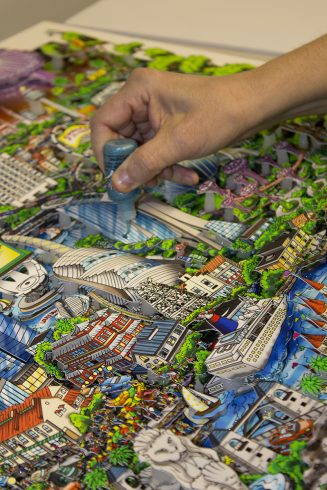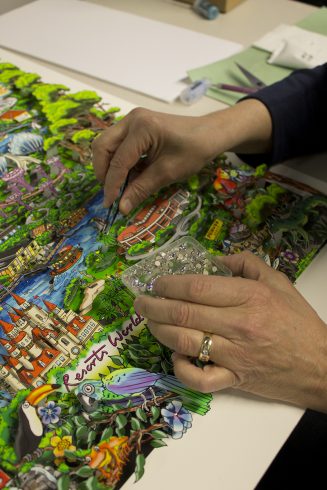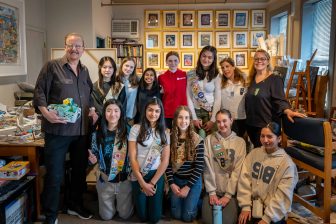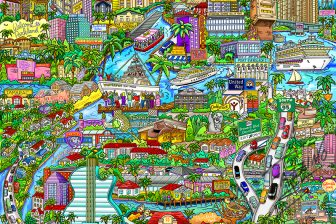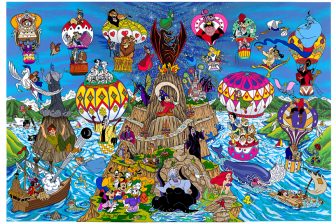In our Fazzino 101 “Course Introduction,” we discussed some of the factors that have played into Charles Fazzino becoming one of the most influential artists of his day. His unique and engaging three-dimensional style has certainly helped distinguish him from his peers. We are astounded by how many collectors of Charles Fazzino’s work do not understand the process he uses. To this day, when we give tours of our studio, we find that people believe that the artwork is made three-dimensional by machine – that it is die cut and machine assembled. Not only has this never been the case, but it never will be the case. Every piece of Fazzino fine artwork is cut, glued, and assembled by hand using an exacto knife. The hand work in each piece, in fact, makes it as close to an original work as you can get in a limited edition, and it’s what makes Fazzino’s artwork even more special. So, let’s explain how it’s done.
The Creative Process
Charles Fazzino, like every other artist, starts out with an idea and puts it down in the form of a pencil sketch. This concept sketch can take days, weeks, or even months to complete and he continues working on it until the entire concept is fleshed out. This phase usually involves a lot of research, as he immerses himself into his subject in order to capture the true essence. Once the sketch is finished, then it is put down with ink, tightened up and then sent to the printer.
Silk Screening
Most Charles Fazzino’s limited edition fine artwork is reproduced using a silkscreen serigraph process. Silk screening is the laying down of colors one by one to built out a complete composition. The process takes six month on average to complete. It is very labor intensive and artistic. The printer begins by covering line art from Charles with a “screen,” or a piece of mylar, and he actually traces off the concept line and tightens it up even further. Then he puts that screen on his silkscreen press which resembles a huge squeegee board, and squeezes black ink through the screen onto paper. After printing the black ink, he ends up with a printed outline of Fazzino’s original concept… almost like a coloring book image.
The coloring books image goes back to Charles and he colors it in using a variety of tools including colored pencils, acrylic paints, pen and ink… depending upon the effect he is trying to render. Then the hand-colored image goes back to the printer.
The printer now has the difficult job of separating all of the colors in the work onto different screens by hand, tracing each one individually. There could be anywhere from 20 to 50 different colors in one piece of artwork, and the printer is knowledgeable about which order to print them in and which to blend together to result in even more colors. The printer creates one screen for each color that he determines needs to be printed. For example, he will cover the art with one screen and trace off all of the elements that are one color green, then he puts that aside, picks up another screen and traces off all of the elements that are a different color green, and so on, until he ends up with as many screens as there are individual colors. He then proceeds to put each screen on the press with the corresponding color ink and squeegees that color onto 10-20 pieces of paper. He then does that with each successive color, cleaning out the press in between each one.
After printing all of the colors, the composition comes together and the resulting proof is sent to Fazzino for approval. At this stage, Fazzino will indicate any alterations he wants the printer to make and then the printer has to make those adjustments, by hand, to each of the screens involved. Now the REAL fun starts because, if we are printing a limited edition of 250 pieces, in order to achieve the 3D effect, the printer will need to print 375 sheets of paper.. That means that 375 sheets of paper are to be individually hand-pulled through the printing press as many times as there are colors in the image. So on day one, he starts with a big stack of blank paper and he puts one color screen on the press with the corresponding paint color and hand pulls 375 sheets of paper through, let’s them dry, and comes back later or the next day to print the next color
If the weather cooperates, he can print one to two colors per day. Why “if the weather cooperates?” Because if the humidity in the air changes too much during the course of printing, then the paper will expand or contract, throwing off the registration of the layers and causing them not to fall in the right places to build out the composition. The printer has to wait until the humidity comes back close to the original levels.
To give you an idea of what that looks like, this is a piece where half the colors have been put down and you see the image starting to come to life… color by color… color by color… and that is silkscreen printing.
The 3D Process
The 375 sheets get sent to our studios from the printer – that’s where most artists stop. They will put the prints in a flat file, pull them out as they are ordered, roll them up into tubes, and send them to customers. For us, this is where the 3D process begins! Half of the edition is printed on a thick 2-ply or 4-ply museum board and half the edition is printed on a thinner rag museum paper sheet. Our Art Director then works with our 40+ freelance artists who each work to cut, glue, assemble, and embellish the art pieces… all by hand. The cutting is done with an exacto knife and the layering is done using a special kind of silicone. We go through about 40,000 tubes of this silicone each year! It’s an incredibly detailed process, one which Charles Fazzino used to do entirely by himself at the beginning of his career. In order to meet demand, he started hiring freelance and apprentice artists to help him with this process more than two decades ago. He oversees the process, indicating to his artists his likes and dislikes in terms of layering and embellishment and relies on his Art Director to manage the process on a day-to-day basis.
The Fazzino creative process is unique, labor-intensive, and quite spectacular to observe. If you happen to be in our area the last weekend in September, come by for the annual New Rochelle ArtsFest. It’s the one time each year when we open our doors, give studio tours, and show you what goes on behind-the-scenes.

